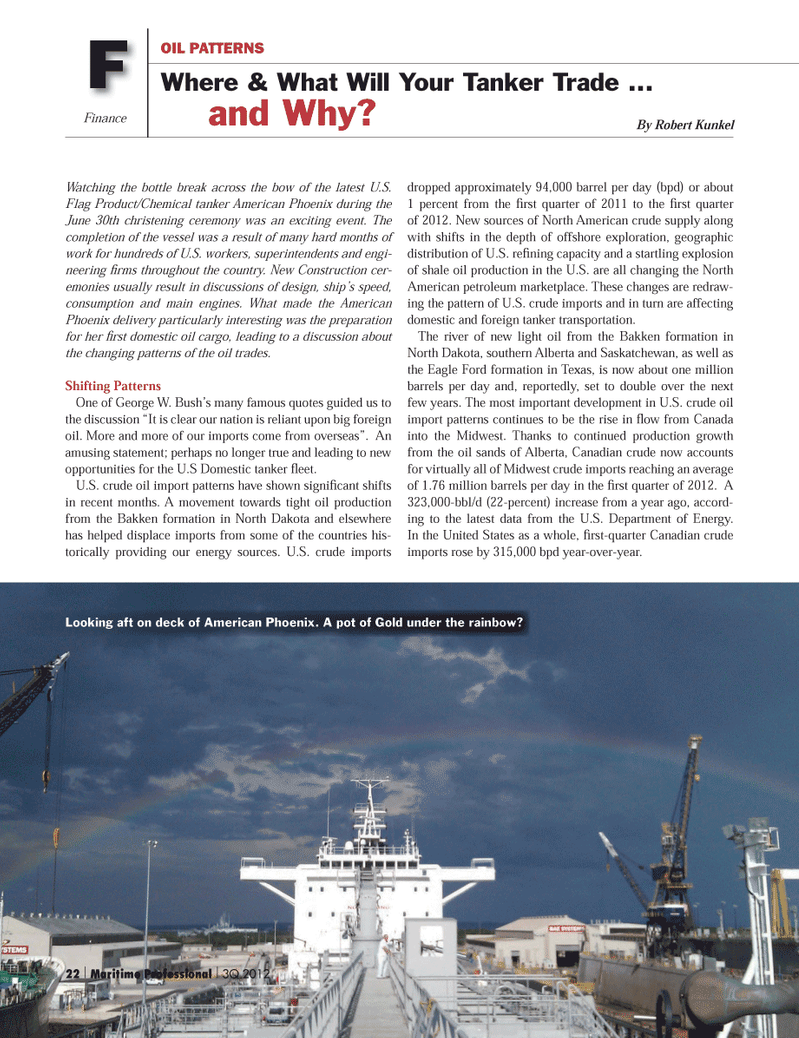
Page 22: of Maritime Logistics Professional Magazine (Q3 2012)
Classification Societies, Quality & Design
Read this page in Pdf, Flash or Html5 edition of Q3 2012 Maritime Logistics Professional Magazine
Watching the bottle break across the bow of the latest U.S. Flag Product/Chemical tanker American Phoenix during the June 30th christening ceremony was an exciting event. The completion of the vessel was a result of many hard months of work for hundreds of U.S. workers, superintendents and engi- neering Þ rms throughout the country. New Construction cer- emonies usually result in discussions of design, shipÕs speed, consumption and main engines. What made the American Phoenix delivery particularly interesting was the preparation for her Þ rst domestic oil cargo, leading to a discussion about the changing patterns of the oil trades. Shifting Patterns One of George W. Bush?s many famous quotes guided us to the discussion ?It is clear our nation is reliant upon big foreign oil. More and more of our imports come from overseas?. An amusing statement; perhaps no longer true and leading to new opportunities for the U.S Domestic tanker eet.U.S. crude oil import patterns have shown signi cant shifts in recent months. A movement towards tight oil production from the Bakken formation in North Dakota and elsewhere has helped displace imports from some of the countries his-torically providing our energy sources. U.S. crude imports dropped approximately 94,000 barrel per day (bpd) or about 1 percent from the rst quarter of 2011 to the rst quarter of 2012. New sources of North American crude supply along with shifts in the depth of offshore exploration, geographic distribution of U.S. re ning capacity and a startling explosion of shale oil production in the U.S. are all changing the North American petroleum marketplace. These changes are redraw- ing the pattern of U.S. crude imports and in turn are affecting domestic and foreign tanker transportation. The river of new light oil from the Bakken formation in North Dakota, southern Alberta and Saskatchewan, as well as the Eagle Ford formation in Texas, is now about one million barrels per day and, reportedly, set to double over the next few years. The most important development in U.S. crude oil import patterns continues to be the rise in ow from Canada into the Midwest. Thanks to continued production growth from the oil sands of Alberta, Canadian crude now accounts for virtually all of Midwest crude imports reaching an average of 1.76 million barrels per day in the rst quarter of 2012. A 323,000-bbl/d (22-percent) increase from a year ago, accord-ing to the latest data from the U.S. Department of Energy. In the United States as a whole, rst-quarter Canadian crude imports rose by 315,000 bpd year-over-year. Finance OIL PATTERNS Where & What Will Your Tanker Trade ... and Why?FBy Robert Kunkel Looking aft on deck of American Phoenix. A pot of Gold under the rainbow?22 | Maritime Professional | 3Q 2012

 21
21

 23
23
